New Acquisitions: The Highlights of 2024
- View news filtered by: Museum Story
- View news filtered by: Museum behind the scenes
- View news filtered by: Collections
- View news filtered by: Conservation
- View news filtered by type: Listicle
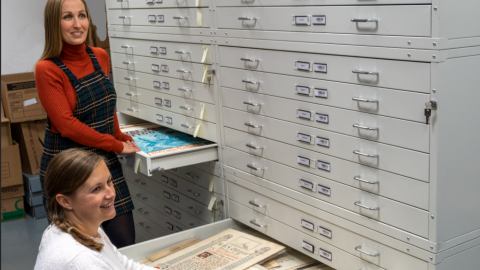
2024 has been a year of significant acquisitions at The National Museum of the Royal Navy.
Formed in 2009, The National Museum of the Royal Navy is the youngest and fastest growing National Museum and we accept hundreds of new items into the Collection every year, thanks to generous gifts from members of the public or through purchase at auction or private sale. We are proud to be the permanent home for some incredible objects and it can feel like Christmas all year around for the Collections Team who have the pleasure of unboxing treasures such as these:
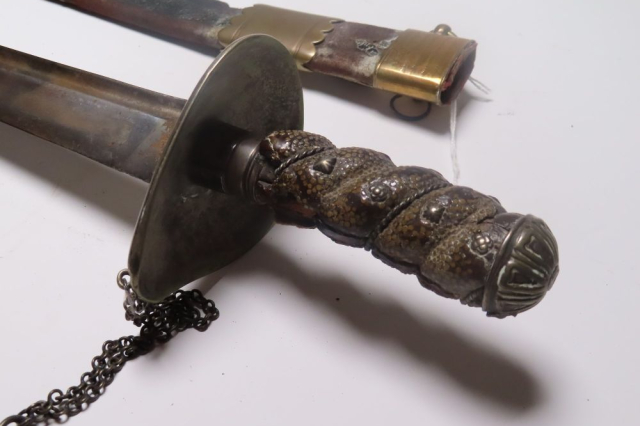
A silver-mounted Spanish cutlass captured by Lord Anson from the Manila Galleon 'Nuestra Señora de Covadonga', 20 June 1743
This sword relates to probably the most famous single ‘prize’ ever taken by the Royal Navy (the galleon was carrying over 33 tonnes of silver).
It rounds off a story of a journey around the world, a squadron being decimated by scurvy (inspiring the search for the eventual cure), the mutiny on the Wager, and finally the capture of this Manilla Galleon, which, due to the losses to scurvy and mutiny, made the surviving crews instantly rich, propelling Anson to fame, fortune (£91,000 – over £10m today) and high rank, and sent the men of the lower deck on a notorious spending spree (they received around £300 each – 20 years’ wages).
It went down in naval legend as the example of the riches that could be gained from naval service, and Anson would prove to be an incredibly important figure as First Lord of the Admiralty.
Caricature of Admiral Earl Richard Howe, 1793
This caricature of Admiral Earl Richard Howe entitled ‘How a Great Admiral with a Great fleet, went a Great way, was Lost a Great while, saw a Great sight - & then came home for little water’ shows the public and press’s attitude towards Howe's command of the Channel Fleet after the French Revolutionary Wars.
Howe sailed with his fleet from October to December 1793 to bring the French fleet to battle but was unable achieve a decisive action and spent several days in port due to bad weather. Some ships from his fleet arrived at Plymouth on 7 December and announced that the fleet had not captured any enemy vessels. Howe’s unsuccessful voyage and his return to Torbay on 12 December drew criticism from the press and public.
Howe later achieved a decisive battle the following year during the Glorious First of June, 1 June 1794.
Finds from the Shipwreck HMS Erebus (found in 2014)
In March 2024, the Museum received a representative sample of artefacts from HMS Erebus. The collection from this iconic ship includes stunning artefacts such as the ship’s bell and a section of the ship’s wheel, personal items such as the plates from a dinner service, scientific instruments relating to the expedition and naval uniform and stores providing a reminder that this was a Royal Navy ship and crew.
The collection represents one of the most famous events in the history of Arctic exploration and a centuries-long mystery surrounding the fate of the Sir John Franklin expedition. The objects have returned to the UK for the first time since leaving on that fateful voyage, completing a 3,500 mile-journey from Canada to Portsmouth in a highly important milestone in the partnership between Parks Canada and The National Museum of the Royal Navy.

The ‘Mad Major’ Medal Set, 1914-1945
'Mad’ Major Christopher Draper, was a flying ace who during the First World War was given command of No 8 Naval Squadron. He was also seriously leading him to protest ostentatiously in London, and his arrest in 1931 for flying under Tower and Westminster Bridges!
Despite this, in the Second World War, Draper returned to service including in the Far East in 777 Fleet Air Arm Squadron. Indeed, he was the only person to command a squadron in both the First and Second World Wars. He is also famous for spying on the Germans after a chance meeting with Adolf Hitler in 1932.
His medal group consists of a Distinguished Service Cross; 1914-1915 Star; British War and Victory Medals; 1939-1945 Star; France & Germany Star; Defence and War Medals; France, Croix de Guerre. We will be putting these incredible medals on display at our Fleet Air Arm Museum in 2025!
Deck Hockey Sticks, 1914
These hockey sticks, made of willow were used on board HMS Caroline. They would have been used by the officers on the upper deck with a puck that floated made of bamboo. When HMS Caroline was in Belfast as a Commissioned ship ‘Deck Hockey’ was played in the drill hall after Trafalgar Night Dinner. Don’t forget you can book to visit HMS Caroline – which is celebrating 100 years in Belfast – online here:
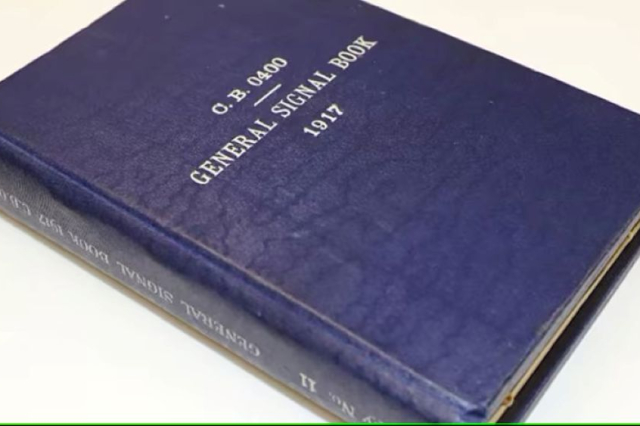
General Signal Book, 1917
An extremely rare lead-lined naval signal book from the First World War was miraculously found in an Oxfam online bookshop in May 2024.
The book, which is filled with confidential signal codes for the Home Fleet, was found with a box of donations at the back of Oxfam's Bath bookshop but thanks to one of the shop’s volunteers who is a retired marine engineer, the Museum was alerted and rescued it for the nation.
Signal books like this were usually ordered to be destroyed once they were no longer in use and the lead-lining would have helped the book sink in case of emergency i.e. if the ship was in danger of being captured by the enemy it could be thrown overboard to avoid falling into the wrong hands.
Watercolour of H22, 1923
Watercolour by W L Wyllie depicting the submarine HMS H22 surfaced out at sea possibly with the Eddystone Lighthouse in the distance. Dated 1923.
HMS H22 was an H-class submarine, launched in 1917 and sold in 1929 to be broken up. The H-class were based on the United States Holland 602 type submarines for coastal defence. The H21 class was built as part of the 1917 Emergency War Programme, in response to the German boats which mined British waters and sank British shipping with ease.
The H-class were the first class of submarine to have 4 torpedo tubes fitted at the bow end. Although they saw little impact during the war, the H-class was such a successful design that over 70 were ordered for Britain, Chile, Canada, Italy and Russia. The longest serving H-boat was in Chile, which was scrapped in 1956. Nine British H boats saw service in the Second World War.
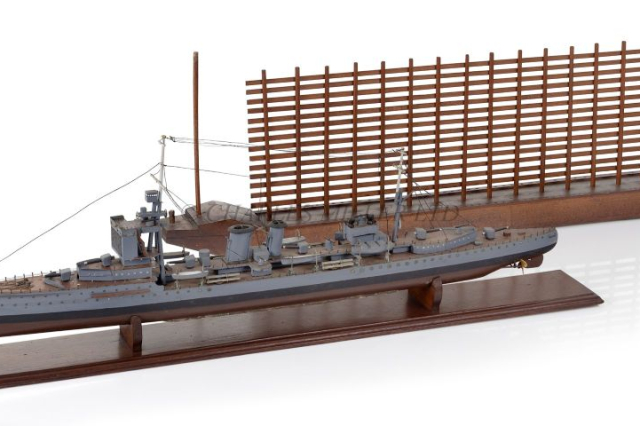
1:192 Scale Model of the ‘Danae’-Class Cruiser HMS Dragon with Gunnery Practice Target Barge, c1924
This is a very rare example of a model depicting the Danae class cruiser HMS Dragon with a gunnery practice target barge, circa 1925. Models that include gunnery target barges are very underrepresented in museum collections - this may now be a unique example within a UK public collection.
Target practice is often depicted via photographs of guns firing at targets but it is highly unusual to see a model being used to interpret this subject. The model belonged to Captain Bernard W M Fairbairn RN whose family donated the following artefacts to the Museum in 2021: a collection of watercolours depicting ships in which Fairbairn served (painted by Fairbairn's wife Alice Mary); a (1914) diary; Armistice documents (1918) and a collection of silver hairbrushes each carrying a Naval Crown on the back.
Fairbairn had earlier served as Gunnery Commander aboard the the armoured cruiser HMS Cochrane, 1913-1915. Before taking command of HMS Dragon in 1922, Fairbairn served as Deputy Director, Gunnery Division 1921-1922. Later, prior to being placed on the Retired List in 1936, Fairbairn served as President of the Ordnance Committee.

German Sextant from the SS Gedania, c1941
On 4 June 1941, HMS Marsdale sighted the SS Gedania. Believing her to be neutral, they attempted to stop the ship but the Gedania refused. The crew of the Gedania set scuttling charges and abandoned ship. A boarding party from the Marsdale led by Lieutenant McGuiness found the crew and instructed the ship’s Captain to board, but three explosions were heard inside the ship. The boarding party managed to plug a hole below the waterline, but due to fears of further scuttling charges they took any documents around such as codebooks and this sextant and returned to the Marsdale.
The codebooks were sent to Bletchley Park and assisted with the breaking of the Enigma codes. The crew of the Gedania spent the rest of the war as Prisoners of War.
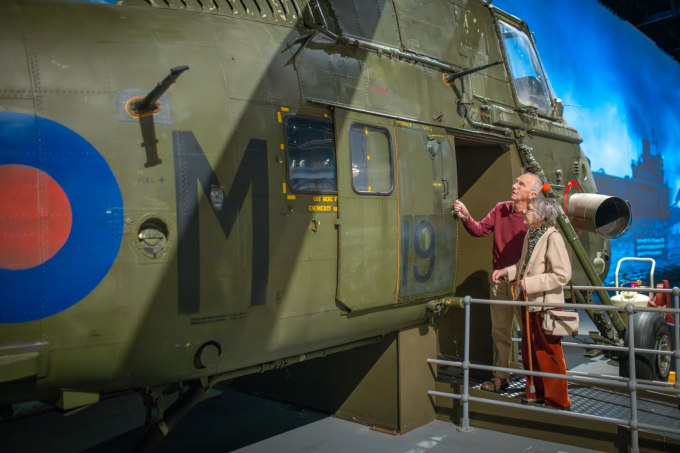
Visit Us
If you’ve enjoyed this small selection of material, why not clear away the cobwebs and Buy tickets to the most inspiring Naval Museum in the world | National Museum of the Royal Navy